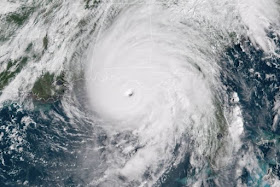USDA Offers Food Safety Tips for Areas Affected by Hurricane Michael
USDA Office of Communications
Press (202) 720-9113
Consumer Inquiries (888) 674-6854
Press (202) 720-9113
Consumer Inquiries (888) 674-6854
WASHINGTON, Oct. 10, 2018 — The U.S.
Department of Agriculture’s (USDA) Food Safety and Inspection Service
(FSIS) is issuing food safety recommendations for those who may be
impacted by Hurricane Michael.
The National Hurricane Center expects storm surge and
hurricane force winds in portions of Florida, Georgia and Alabama. Heavy
rainfall from Hurricane Michael could produce flash flooding from the
Florida Panhandle and Big Bend region into portions of Georgia, South
Carolina, North Carolina and southeast Virginia.
Hurricanes present the possibility of power outages and
flooding that can compromise the safety of stored food. Residents in the
path of this storm should pay close attention to the forecast. FSIS
recommends that consumers take the following steps to reduce food waste
and the risk of foodborne illness during this and other severe weather
events.
Steps to follow in advance of losing power:
- Keep appliance thermometers in both the refrigerator and the freezer to ensure temperatures remain food safe during a power outage. Safe temperatures are 40°F or lower in the refrigerator, 0°F or lower in the freezer.
- Freeze water in one-quart plastic storage bags or small containers prior to a storm. These containers are small enough to fit around the food in the refrigerator and freezer to help keep food cold. Remember, water expands when it freezes, so don’t overfill the containers.
- Freeze refrigerated items, such as leftovers, milk and fresh meat and poultry that you may not need immediately—this helps keep them at a safe temperature longer.
- Know where you can get dry ice or block ice.
- Have coolers on hand to keep refrigerator food cold if the power will be out for more than four hours.
- Group foods together in the freezer—this ‘igloo’ effect helps the food stay cold longer.
- Keep a few days’ worth of ready-to-eat foods that do not require cooking or cooling.
Steps to follow if the power goes out:
- Keep the refrigerator and freezer doors closed as much as possible. A refrigerator will keep food cold for about four hours if the door is kept closed. A full freezer will hold its temperature for about 48 hours (24 hours if half-full).
- Place meat and poultry to one side of the freezer or on a tray to prevent cross contamination of thawing juices.
- Use dry or block ice to keep the refrigerator as cold as possible during an extended power outage. Fifty pounds of dry ice should keep a fully-stocked 18-cubic-feet freezer cold for two days.
Food safety after a flood:
- Do not eat any food that may have come into contact with flood water—this would include raw fruits and vegetables, cartons of milk or eggs.
- Discard any food that is not in a waterproof container if there is any chance that it has come into contact with flood water. Food containers that are not waterproof include those packaged in plastic wrap or cardboard, or those with screw‐caps, snap lids, pull tops and crimped caps. Flood waters can enter into any of these containers and contaminate the food inside. Also, discard cardboard juice/milk/baby formula boxes and home-canned foods if they have come in contact with flood water, because they cannot be effectively cleaned and sanitized.
- Inspect canned foods and discard any food in damaged cans. Can damage is shown by swelling, leakage, punctures, holes, fractures, extensive deep rusting or crushing/denting severe enough to prevent normal stacking or opening with a manual, wheel‐type can opener.
Steps to follow after a weather emergency:
- Check the temperature inside of your refrigerator and freezer. Discard any perishable food (such as meat, poultry, seafood, eggs or leftovers) that has been above 40°F for two hours or more.
- Check each item separately. Throw out any food that has an unusual odor, color or texture or feels warm to the touch.
- Check frozen food for ice crystals. The food in your freezer that partially or completely thawed may be safely refrozen if it still contains ice crystals or is 40°F or below.
- Never taste a food to decide if it’s safe.
- When in doubt, throw it out.
FSIS’ YouTube video “Food Safety During Power Outages” has instructions for keeping frozen and refrigerated food safe. The publication “A Consumer’s Guide to Food Safety: Severe Storms and Hurricanes” can be downloaded and printed for reference during a power outage. Infographics on FSIS’ Flickr page
outline steps you can take before, during and after severe weather,
power outages and flooding. FSIS provides relevant food safety
information during disasters on Twitter @USDAFoodSafety and Facebook.
If you have questions about food safety during severe
weather, or any other food safety topics, call the USDA Meat &
Poultry Hotline at 1-888MPHotline or chat live with a food safety
specialist at AskKaren.gov.
These services are available in English and Spanish from 10 a.m. to 6
p.m. Eastern Time, Monday through Friday. Answers to frequently asked
question can also be found 24/7 at AskKaren.gov.




